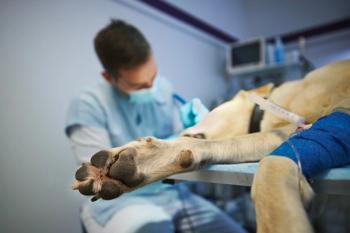
- Vetted June 2020
- Volume 115
- Issue 6
On shaky ground: Discerning true seizures from imposters in veterinary medicine
Seizures are damaging to the body, so their myriad effects must be managed properly and recurrence prevented. But the first hurdle for veterinarians is distinguishing actual seizure disorders from the many conditions that can masquerade as such.
Many disorders in veterinary patients involve abnormalities of movement and mentation, and they may look like seizures. That's why the first challenge in managing “seizures” is determining whether what's occurring is, in fact, a seizure.
“The abnormal activity that is happening might only be occurring at home,” said Simon Platt, BVM&S, FRCVS, DACVIM, DECVN, professor of neurology at the University of Georgia College of Veterinary Medicine, during a lecture at the 2019 Atlantic Coast Veterinary Conference. “So, owners should be instructed to videotape these episodes, when possible, and submit them for veterinary review.”
So, what differentiates seizure mimics from actual seizures? Dr. Platt divided the mimics into five categories based on physiology and clinical characteristics.
Syncope
Unlike the rigidity that characterizes seizures, the hallmark of syncope is acute, flaccid collapse associated with activity. These episodes are abrupt, transient and typically accompanied by a brief loss of consciousness.
Syncopal episodes result from a sudden, global reduction in perfusion secondary to cardiac compromise. If syncope is suspected, a cardiac workup should be performed and a Holter monitor used to determine whether a cardiac condition is present.
Movement disorders
Movement disorders encompass a broad category of abnormal physical activity. “[The animals] either move too much or move too little,” Dr. Platt explained.
Involuntary motions are mostly present during inactivity. They involve no loss of consciousness, may be local or generalized, and are often breed related. The difference between movement disorders and seizures is that the patient is responsive during movement disorder events.
Most movement disorders in dogs are paroxysmal dyskinesias that feature intermittent, episodic, involuntary movements and abnormalities of muscle tone in conscious individuals. They are often triggered by stress or sudden movement. These include:
Scottie cramps. This autosomal-recessive disease affects young (<3 years old) Scottish terriers. Scottie cramps are involuntary episodes of spinal arching and limb rigidity brought on by stress and/or excitement; they typically resolve within 10 minutes. Thought to be caused by a serotonin deficiency, this nonprogressive disease sometimes responds to treatment with selective serotonin reuptake inhibitors.
Episodic hypertonicity of Cavalier King Charles spaniels. This nonprogressive disease, also known as episodic falling syndrome, is characterized by stiffening of the thoracic and pelvic limbs, followed by collapse. Affected dogs remain conscious during episodes, which are precipitated by stress, excitement and exercise. This condition, which typically presents between ages 3 and 7 months, involves an autosomal-recessive gene deletion carried by about one in 10 cavaliers. Clonazepam and acetazolamide are effective in mitigating clinical signs.
Border terrier cramping syndrome. These two- to 20-minute episodes of epileptic cramping feature dystonia, tremors and difficulty ambulating, affecting dogs by around 3 years of age. The gastrointestinal tract and skin may also be involved. Gluten hypersensitivity has been implicated, and dietary changes have been effective in some dogs.
Lafora disease. This syndrome, which features repetitive muscular contractions brought on by visual, auditory and tactile stimuli, is familial in miniature wire-haired dachshunds. It typically manifests between the ages of 6 and 13 years, and is diagnosed by muscle biopsy.
Dancing Doberman disease. The intermittent involuntary flexion of one or both pelvic limbs gives affected dogs a high-stepping gait that could mimic seizure-like tremors. Muscle atrophy and weakness may also be seen.
Head bobbing. These idiopathic tremors occur at rest and cease when the dog resumes activity. Inherited in Dobermans, boxers and American bulldogs, the condition usually begins before age 2 and can be associated with anxiety.
Orthostatic tremors. These postural tremors occur only when standing. They are familial in Great Danes and Scottish deerhounds, present when dogs are young and sometimes respond to gabapentin.
Neuromuscular collapse. Also known as “exercise-induced collapse,” neuromuscular collapse manifests as weakness in the hind (and sometimes all) limbs and collapse following five to 20 minutes of intense exercise. This inherited disease is common in Labrador retrievers but is also seen in other breeds, primarily retrievers, spaniels and pointers. Because of the rapid onset, abnormal gait, possible increase in muscle tone and collapse, many owners mistake these events for seizures.
Sleep disorders. Inappropriate movements during sleep and inappropriate sleep during movement can both masquerade as seizure disorders. During the rapid eye movement (REM) phase of sleep, muscles become generally atonic and, therefore, still. But some dogs exhibit violent limb movements, biting, howling and growling in their sleep. There is also some breed predilection involved. Dr. Platt said that an estimated 30% of golden retrievers are affected and sometimes treated inappropriately based on a seizure misdiagnosis.
Behavioral disorders
Compulsive behavioral disorders share certain commonalities with seizures: Both can involve repetitive, unvarying movements that have no apparent goal or function. These actions include locomotor and oral movements, aggressive motions, vocalization and hallucinatory demeanor. Compulsive behaviors are multifactorial and can be caused by stress, conditioning, genetics and medical conditions. They are treated very differently from seizures, with opioid, serotonergic, dopaminergic or glutamatergic medications, highlighting the importance of flagging seizure imposters.
The bottom line
Dr. Platt illustrated the difficulty for both owners and veterinarians in distinguishing seizures from disorders of behavior, sleep, motion, muscle tone and the cardiovascular system. He cited a recent study in which veterinary neurologists were asked to
A careful eye and a healthy dose of scrutiny are critical in managing “seizure” cases, Dr. Platt concluded: “You don't need to medicate every case. Some of these [seizure mimics] don't really affect the dog, only the owner.”
Dr. Capuzzi, who earned her BS and VMD degrees from the University of Pennsylvania, works in small animal practice in the Philadelphia area and is a published author. She has written for The Philadelphia Inquirer, Time, Business Philadelphia, Dog Fancy and Dog World, among others. She is especially interested in public health and animal welfare, and is involved with several organizations whose missions are to improve the lives of domesticated and wild animals.
Articles in this issue
over 5 years ago
Possible IMHA dog—now what?over 5 years ago
What will ‘normal’ look like after COVID-19?over 5 years ago
Fighting online veterinary pharmacies … and winningover 5 years ago
The real reasons why some veterinary team members don’t careover 5 years ago
For better veterinary feeding information, change your questionover 5 years ago
Telemedicine: more than just video chatsover 5 years ago
What Luke Skywalker has to do with veterinary practice marketingalmost 6 years ago
Don’t sell product sales shortNewsletter
From exam room tips to practice management insights, get trusted veterinary news delivered straight to your inbox—subscribe to dvm360.






